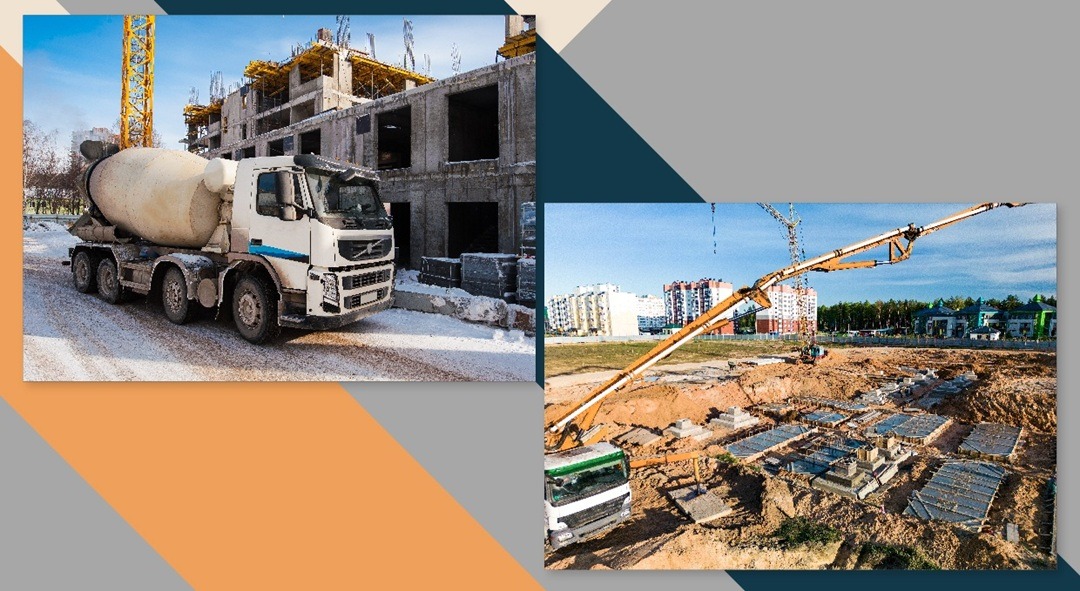Concrete mix proportion is the ratio of cement, sand, aggregate, and water used to create concrete with specific strength and durability. Getting this balance right determines whether your construction project stands strong for decades or develops cracks within years.
The mix proportion of concrete directly impacts compressive strength, workability, and resistance to environmental conditions. A typical mix like 1:2:4 means one part cement, two parts sand, and four parts coarse aggregate by volume. Different construction applications require different ratios based on the load they’ll carry and the conditions they’ll face. Understanding mix proportions helps you avoid costly mistakes like using too much water, which weakens concrete, or too little cement, which affects binding.
What is Concrete Mix Proportion?
The mix proportion of concrete is the specified ratio of cement, fine aggregate (sand), coarse aggregate (gravel or crushed stone), and water combined to produce concrete with desired properties.
Getting the proportions right is everything in concrete work. Too much of one ingredient or too little of another changes how the concrete performs. The cement acts as the binder that holds everything together. Sand fills the voids between larger aggregate pieces. Coarse aggregate provides bulk and strength. Water activates the cement and makes the mix workable.
Why correct proportioning matters:
- Controls the compressive strength that concrete achieves after curing
- Affects workability during pouring and finishing
- Determines durability against weathering and chemical attack
- Impacts shrinkage and cracking potential
- Influences the final cost per cubic meter
Each ingredient plays a specific role. Cement provides the binding power through chemical reactions with water. Fine aggregate (sand) fills small spaces and helps with workability. Coarse aggregate gives concrete its volume and strength while reducing costs since aggregate is cheaper than cement. Water triggers the chemical reaction and provides workability, but excess water seriously weakens the final product.
Types of Concrete Mixes
Concrete mixes fall into three main categories based on how proportions are determined and their intended applications.
Nominal Mix Concrete
Nominal mix concrete uses predetermined fixed proportions without detailed engineering calculations. These standardised ratios, like 1:2:4 or 1:3:6, work for general construction where extreme precision isn’t critical.
Common nominal mixes include:
- M5 and M7.5: Very lean mixes for levelling courses and foundations
- M10: Non-structural work like pathways and bedding layers
- M15: General construction, including foundations and floors
- M20: Moderate strength for residential slabs and beams
Nominal mixes are quick to specify and easy to understand. Contractors know these ratios well. However, they don’t account for variations in material quality or specific project demands. They’re typically used for smaller projects or non-critical elements.
Standard Mix Concrete
Standard mixes like C25 Concrete and C30 Concrete fall between nominal and design mixes. They follow established proportions but with more attention to material properties and quality control.
These mixes suit most commercial and residential construction. M25 is common for reinforced concrete structures. M30 works for heavy-duty applications. The proportions follow tested formulas that deliver consistent results when materials meet specified standards.
Design Mix Concrete
Design mix concrete is engineered specifically for a project based on required performance characteristics. A qualified engineer calculates exact proportions considering all variables.
Design mixes account for:
- Actual material properties through lab testing
- Specific strength requirements
- Environmental exposure conditions
- Special performance needs like high durability or rapid strength gain
- Economic optimisation
Large infrastructure projects, bridges, high-rise buildings, and specialised applications typically require design mixes. The engineer tests the actual cement, sand, and aggregate to be used, then calculates precise proportions. This ensures the concrete meets exact project specifications.
Get Smae Day Delivery: 020 7458 4747
Common Concrete Mix Ratios and Grades
Different construction applications need different concrete strengths, achieved through varying mix proportions.
1:2:4 Mix (M15)
This ratio means one part cement, two parts sand, and four parts coarse aggregate. M15 grade concrete achieves approximately 15 MPa (2175 psi) compressive strength after 28 days.
Typical uses:
- Residential foundations and footings
- General flooring and pathways
- Non-load-bearing walls
- Moderate strength applications
The 1:2:4 mix is probably the most well-known ratio. It strikes a balance between strength and economy for everyday construction. Many small contractors default to this for basic residential work.
1:1.5:3 Mix (M20 or C20 concrete)
One part cement, 1.5 parts sand, and three parts aggregate create C20 concrete with roughly 20 MPa (2900 psi) strength.
Best for:
- Load-bearing columns and beams
- Reinforced concrete slabs
- Structural elements in residential buildings
- Applications requiring good strength
M20 is the workhorse of residential construction. It provides adequate strength for most home-building needs while remaining economical. The reduced aggregate ratio compared to M15 increases cement content for better binding.
1:1:2 Mix (M25/M30)
This richer mix uses one part cement, one part sand, and two parts aggregate. It produces high-strength concrete reaching 25 to 30 MPa (3625 to 4350 psi).
Applications:
- Heavy-duty industrial floors
- Precast concrete elements
- High-rise building columns
- Structures facing severe conditions
The higher cement content makes this mix more expensive but delivers significantly better strength and durability. It’s essential for critical structural elements and demanding applications.
Other Common Mixes
- 1:3:6 Mix (M10): Very lean mix for non-structural uses like levelling courses, bedding for pipes, and temporary structures. Achieves about 10 MPa strength.
- 1:4:8 Mix: Extremely lean concrete for mass concrete work, foundation filling, and situations where strength isn’t critical but volume is needed.
Quick Reference Table
Mix Ratio | Grade | Strength (MPa) | Typical Uses |
1:4:8 | M5 | 5 | Levelling, lean mass concrete |
1:3:6 | M10 | 10 | Pathways, bedding, non-structural |
1:2:4 | M15 | 15 | General construction, foundations |
1:1.5:3 | M20 | 20 | Load-bearing beams, slabs |
1:1:2 | M25 | 25 | High-strength, industrial floors |
1:1:2 | M30 | 30 | Heavy-duty, precast elements |
4 Factors Affecting the Mix Proportion
Several variables influence what proportions work best for your specific situation.
Water-Cement Ratio Impact
The water-cement ratio is probably the single most important factor affecting concrete strength. Lower ratios produce stronger concrete but reduce workability. Higher ratios make mixing and pouring easier, but seriously weaken the final product.
A concrete mix with a 0.6 water-cement ratio offers much greater workability compared to one with a 0.35 or 0.4 ratio. The extra water makes the concrete flow more easily and simplifies placement. However, this convenience comes at a significant cost to strength and durability.
Typical water-cement ratios range from 0.4 to 0.6 by weight. A ratio of 0.5 means 50 kg of water per 100 kg of cement. Going below 0.4 makes the concrete too stiff to work with. Going above 0.6 creates weak, porous concrete prone to cracking.
Workability Requirements
Workability describes how easily concrete flows, spreads, and consolidates. Complex formwork with tight reinforcement spacing needs more workable concrete. Simple flat slabs can use stiffer mixes.
More cement paste relative to aggregate increases workability but costs more. Chemical admixtures called plasticisers improve workability without adding water.
Durability and Exposure Conditions
Concrete exposed to freeze-thaw cycles, chemicals, or seawater needs different proportions than interior concrete. Harsh environments require:
- Lower water-cement ratios for denser concrete
- Higher cement content for better protection
- Specific cement types resistant to sulfates or chlorides
- Air-entraining admixtures for freeze-thaw resistance
Aggregate Characteristics
The size, shape, and grading of aggregates affect required proportions. Well-graded aggregate with a good mix of sizes packs efficiently, needing less cement paste. Angular crushed stone creates stronger bonds than smooth river gravel but needs more paste for workability.
Maximum aggregate size also matters. Larger aggregate reduces cement needs but won’t fit in thin sections or between tight reinforcement bars.
How to Calculate or Adjust Mix Proportions?
Getting the right mix involves understanding concrete measurement calculator methods and adjustment techniques.
By Volume vs. By Weight Methods
Volume measurement uses buckets or boxes to measure materials. One shovel of cement, two shovels of sand, four shovels of aggregate. It’s simple but less accurate because materials have different densities, and moisture content affects volume.
Weight measurement is more precise. Materials are weighed according to calculated masses. Professional operations are always measured by weight because it accounts for density differences and moisture in aggregates.
For small jobs, volume works fine if you’re consistent. For anything structural or large-scale, measure by weight for reliable results.
Using Trial Mixes and Quality Control
Professional mix design involves creating trial batches, testing them, and adjusting proportions.
The process:
- Calculate initial proportions based on required strength and materials
- Prepare trial batches with slight variations
- Test workability using slump tests
- Cast test cylinders and cure them
- Test compressive strength at 7 and 28 days
- Adjust proportions based on results
The slump test measures workability by seeing how far the concrete slumps when a cone-shaped mould is removed. Different applications need different slumps. Stiff concrete might slump 25-50mm. Highly workable concrete might slump 100-150mm.
Typical Errors and How to Avoid Them
Common mistakes:
- Too much water: The most frequent error. Extra water makes mixing easier, but severely weakens concrete. Stick to calculated ratios even if concrete seems stiff.
- Inaccurate measurements: Eyeballing proportions leads to inconsistent quality. Use consistent measuring containers or scales.
- Dirty materials: Sand contaminated with clay or aggregate with dust affects bonding. Use clean materials.
- Wrong aggregate sizes: All large or all small aggregates don’t pack well. Use specified aggregate grading.
- Ignoring material moisture: Wet sand weighs more than dry sand. Account for moisture when measuring by weight.
Prevention strategies:
Use batch plants or volumetric mixers for large projects. They ensure consistent proportions. For hand mixing, designate specific containers for each material and fill them level every time. Keep materials covered and clean. Test batches before full production.
Bottom Line
Understanding the mix proportion of concrete is fundamental to successful construction. Whether you’re using a simple 1:2:4 nominal mix for a garden path or an engineered design mix for a commercial building, the ratio of cement, sand, aggregate, and water determines everything from strength to durability.
The key takeaways are straightforward. Match the mix grade to your structural requirements. Control the water-cement ratio strictly. Measure accurately by weight when possible. Account for environmental conditions and workability needs. And when in doubt, consult with concrete professionals who understand local materials and conditions.
Getting concrete proportions right the first time saves money, prevents structural problems, and ensures your construction stands the test of time. Pro-Mix Concrete delivers precisely proportioned concrete mixes engineered for your exact specifications. Our experienced team calculates custom mix designs based on your project requirements, local conditions, and performance goals.
We’ve got the expertise and quality materials to make your project succeed. Your structure deserves concrete you can trust. Let Pro-Mix Concrete be your foundation for success.
Frequently Asked Questions
What is the standard mix ratio for concrete?
The standard nominal mix for general-purpose concrete is typically 1 part cement, 2 parts sand, and 4 parts aggregate (1:2:4), achieving M15 grade with 15 MPa strength. However, ratios vary significantly based on required strength and specific construction needs.
How do you choose the right concrete mix proportion for a project?
Mix selection depends on required strength grade, structural element type (slab, beam, column, footing), workability requirements, and exposure conditions. Load-bearing elements need higher grades like M20 or M25, while non-structural work can use M10 or M15.
What happens if the concrete mix ratio is not correct?
Incorrect proportions result in weak or brittle concrete, excessive shrinkage and cracking, reduced durability against weather and chemicals, poor workability during pouring, and potential structural failures. Too much water is especially damaging to strength and long-term performance.
What is the difference between nominal mix and design mix concrete?
Nominal mix uses predetermined standard ratios like 1:2:4 without detailed calculations, suitable for general work. Design mix is engineered specifically for a project through testing and calculations, accounting for actual material properties and exact performance requirements for critical structures.
Can you use less cement to save costs in concrete?
Reducing cement cuts initial material costs but severely compromises strength, durability, and long-term performance. The savings are a false economy when concrete fails prematurely, requiring expensive repairs or replacement. Use appropriate cement content for the required grade and application.
- Dennis Broderick
- Dennis Broderick is the founder and owner of Pro-Mix Concrete Company, a trusted name in ready-mix concrete solutions across the UK. With over 20 years of hands-on experience in the construction and concrete industry, Dennis brings unmatched expertise, practical insights, and a commitment to quality on every project - from residential driveways to large-scale commercial developments.
BlogNovember 15, 2025What is the Mix Proportion of Concrete?
BlogOctober 30, 2025Same-Day and Next-Day Delivery Options from London Concrete Suppliers
BlogOctober 28, 2025Line Pump Hire vs. Boom Pump Hire Prices in London
BlogOctober 25, 2025How Quickly Concrete Must Be Used Once Delivered In London Traffic








